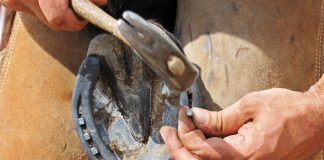
First diagnosed in Lyme, Conn., (hence its name), Lyme disease is most prevalent in the Northeast and Mid-Atlantic states; Vermont had the highest percentage of Lyme disease in the country in 2014, followed by New Hampshire.
Dr. Heather Hoyns, owner of Evergreen Equine in Vermont, estimates that she used to treat several horses a month for Lyme disease, but now she is treating only two to three afflicted horses a summer. She credits this decrease in incidence to owners being educated on how to prevent Lyme disease as well as the off-label use of the canine Lyme disease vaccine.
Dr. Hoyns notes that while there is no “approved” Lyme vaccine for horses, anecdotal evidence suggests that the dog vaccine is very effective in horses. “The recommendation for initial vaccination is one dose on day one, one dose 3 weeks later and a third dose at 3 months. Vaccination is then recommended every 6 months before ticks come out [late February to early March] and late summer/early fall before the fall ‘rise’ in tick numbers [late August/early September].”
Preventing Lyme Disease Infection
Deer ticks are the primary transmitters of Lyme disease, but other types of ticks can also carry the disease. In her practice, Dr. Hoyns encourages her clients to keep ticks off their horses in the first place.
“Lyme disease is caused by a spiral-shaped bacteria called a spirochete,” explains Dr. Hoyns. “Because the spirochete is able to change its presentation to the mammal host immune system, it can escape detection—and destruction—by the immune system.” This ability to change the way it is presented is one reason why it’s difficult to treat and “cure” Lyme disease, she notes.
Ticks climb up tall vegetation, hold on with the legs on one side of their body and hold out the legs on the opposite side of their body, grasping onto whatever comes along. Keeping vegetation closely mowed will help control the tick population. Also, keeping your horse’s trail banged (trimmed) or tied up can also help decrease the likelihood that a tick will latch on to your equine. Applying insect repellants that contain Permithrin, especially on the legs, tail and under the jaw, can help keep ticks at bay; fipronil spray also works well. The use of “tick tubes,” which are permethrin-impregnated cotton in tubes that mice take back to their nest that kills the ticks on the mice, can also help.
It take about 24 hours once a tick has latched on to your steed for him to transmit Lyme disease, so checking your horse daily and removing any ticks you find is vitally important. However, don’t just yank off a tick you see on your horse; you’ll need to use a tick remover or remove the tick using tweezers to grasp the tick’s head to avoid forcing more saliva into your horse’s system. If you notice your horse has any kind of reaction to where the tick had been, call your veterinarian to discuss Lyme disease treatment or testing options.
A Difficult Diagnosis
Lyme disease diagnosis can be difficult. Known as the “great imitator,” Lyme disease can resemble other diseases and is often a fall-back diagnosis after ruling out many other more-traditional equine problems or diseases, including vitamin E and selenium deficiencies.
Horses affected with Lyme disease may be repeatedly “off,” with no definitive cause—they could be quite lame one day, then be almost sound another day. Additionally, the limb that seems to be affected also changes.
Affected horses may also have muscle pain. Some “horses seem whole-body sore, [with] muscles painful to palpation and stiffness,” notes Dr. Hoyns. These horses may also have increased skin sensitivity and dislike grooming, even if they once enjoyed it. Horses with Lyme disease may also show personality and behavioral changes, which may mimic gastric or other intestinal ulcers symptoms. Their performance may diminish and they may also have swelling in their joints (this symptom occurs occasionally). Some horses may also develop inflammation of the interior of the eye (anterior uveitis) or even neurologic symptoms, though this is rare.
A Lengthy Treatment Plan
While Dr. Hoyns has seen a plethora of Lyme disease cases, she describes an “average” Lyme disease case: She gets a call that the horse “isn’t right,” that he’s stiff, has gotten progressively more sore when brushed, isn’t very willing to work and might have had a fever one day this week, but he doesn’t currently have one.
When Dr. Hoyns goes out to see the horse, he doesn’t come up lame on his physical exam. His flexions are normal and his Vitamin E and selenium are all within the normal range. The horse’s legs are not swollen, but he is sore to deep muscle palpation.
After a positive Lyme diagnosis from bloodwork, Dr. Hoyns treats the horse with five days of intravenous Tetrecycline, then with Minocycline twice a day for 30 days. Dr. Hoyns would also recommend that the horse be vaccinated against Lyme disease before, during and after his treatment.
The horse is retested in 30 days, and thought he would still be “positive” by titer count, a 50 percent drop in titer percentages indicates that the treatment is effective.
Doxycycline used to be the gold standard for treating horses with Lyme disease, but the drug has gotten extremely expensive, says Dr. Hoyns. She has also treated one horse that was extremely sensitive to doxycyline, so she inserted a long-term IV catheter in his neck to allow his owner (a registered nurse) to give IV tetracycline for 30 days. Dr. Hoyns said that the horse is alive and well, and currently testing negative for Lyme disease.
While the treatment for Lyme disease can sound intimidating and long-term, the prognosis is very good for horses that are treated in a timely manner. For horses that are not diagnosed fairly rapidly, Lyme disease can progress into the heart, joints and even brain of an infected equine. Horses affected in these manners have a much poorer prognosis. While not necessarily fatal, the horse’s performance and comfort could be greatly affected.
Liked this article? Here are others on Lyme disease:
8 Things to Know about Lyme Disease
Lyme Disease Outbreak
Sarah Coleman has a soft spot for chestnuts with chrome, including her two off-the-track Thoroughbreds that she competes in the hunters. Based in Lexington, Ky., she is the Director of Education and Development for New Vocations Racehorse Adoption Program.






great info
Oh, those nasty little tic, of all shapes and colors cause so much trouble. We, have guinea hens and chickens which help a hold lot to keep them under control.